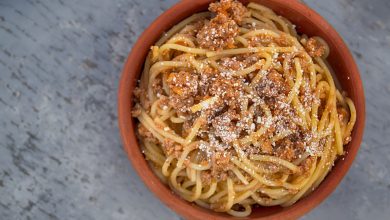
Snack-Flight Mode: What to Eat When Traveling
No one wants to be stuck on a plane with the munchies. Besides the fact that airplane food (especially on domestic flights) is notoriously not the best, it’s also not the best nutrition-wise (think high-calorie snack packs and cookies). To top it all off, you have to pay exorbitant prices to eat what too often amounts to a bunch of junk. So what can you bring with you, and how, to avoid having to choose between being ravenously hungry while stuck in a tiny seat or having to botch your diet plan?
What are some of the best things to take on a plane?
Protein is a great option when stuck on the tarmac or in the air. Protein packs a punch, keeping you fuller for longer, while usually being pretty solid on the healthy side, at least in terms of being real food. Things like jerky, grilled turkey, or cheese sticks are an easily-portable solution for protein without being smelly. While stuff like tuna or eggs are also great protein sources, you might not want to open those up on the plane (or at least your neighbors probably don’t want you to). Fruit and veggies, meanwhile, are also easy, healthy snack items that travel well for the most part, especially if they’re dried. Nuts and seeds satisfy the urge to snack along with a host of health benefits (maybe avoid peanuts), and, if you’re feeling adventurous, you can even take a look into bringing some options like greek yogurt or hummus. Just make sure, however, that you’re staying under the Transportation and Security Administration’s 3.4-ounce limit for carry-on bags, or you’ll get your tasty in-flight snack confiscated as a TSA snack and be left empty-handed on the plane, victim to the in-flight offerings. (Yogurt and such are too gel-like to skate by the 3-1-1 regulation.)
If you want to avoid the airline cookie trap, you can tote with you some healthy options like high-cocoa-content (70 percent is a good target) dark chocolate (no TSA issues here). Bars are always a good option as well for traveling, since they don’t require much thought in packing. You can find bars in the form of fruit bars, protein bars (just check they don’t have tons of additives), and even nut butter bars, as well as granola. Carby snacks are pretty easy to come by, and travel well – like crackers, popcorn, and tortilla chips or rice cakes. You’ll just want to choose healthy options here as well, without lots of fillers and ideally with a bit more fiber. Last but not least, don’t skimp on bringing water. You can bring an empty bottle with you through security (don’t fill it first or you won’t come out with a water bottle on the other side!) and fill it at a fountain at your gate. Airlines are pretty good about offering water on planes, but sometimes the air is so dry that drinking by the cup won’t feel like enough, and if it’s a long-haul flight, complimentary water bottles might run out – leaving you, quite literally, high and dry.
How can I bring cold items with me?
The lunchbox is a trusty tool in refrigeration. However, if you don’t want to look like you’re headed off to school on your first day, there are actually travel lunchbox options that help keep your food cold and you your professional cool. Some will even offer an insulated compartment on one side for your munchies and space on the other side for your laptop. And then there are the adult-picnic bags that can fit an entire smorgasboard inside. One Kings Lane even offers a bag that holds an entire wine bottle on the side – which, no, you won’t be able to get through security, but it could be a handy place to stash your post-security water bottle for easy access if your bag is stowed under the seat in front of you. Space is the only other thing to keep in mind when choosing a bag. You could stash your snacks in the overhead bin, but it might not be convenient if you happen to get hungry when the seatbelt sign is on or the meal cart is blocking the aisle – and then those in-flight snack packs might start looking good again when they pass by. If you’re really serious about your cold food and want to make sure your bag is plane-friendly, you can even take a look at the “crew coolers” from the online store Flight Attendant Shop.
In addition to snacks, don’t forget that you can always combine elements to make a meal. For example, veggies and hummus or yogurt and granola (if you want to eat on the light side) make neat travel bites. If you want to go bigger, you can even add together a few items like a packet of dressing with a salad and some grilled chicken, or mix it all up together before you go. The biggest things you’ll want to avoid when choosing flight food are things that would require too much prep, stuff that will get too messy, and – again – anything smelly that you wouldn’t want the person next to you eating, regardless of their diet goals (this includes garlic and stinky veggies and cheeses, in addition to things like tuna fish). Also keep in mind the TSA guidelines when choosing your snacks. Beyond that, eating healthy (and probably more tastily as well) on the plane might be a lot easier than you think – and you won’t be stuck with the munchies at 35 thousand feet.



